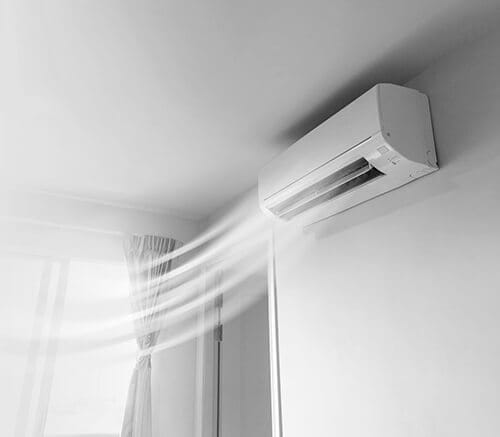April 18, 2022

Not every home in St. Louis is built to support a central HVAC system.
If you live in a house with insufficient HVAC ductwork or absolutely no ductwork at all, you may be tired of relying on ceiling fans, standing fans, and inefficient window air conditioners during the summer months. Fortunately, ductless air conditioning provides the same reliable performance that central A/C systems do. These systems are flexible enough for meeting the needs of everyone in the home. They’re also easy to install. Keep reading to find out exactly how these relatively new options in home cooling equipment work.
What Is a Ductless Air Conditioner?
Also known as mini-splits or ductless mini-splits, ductless air conditioners have an outside compressor and multiple indoor air handlers. For every room or zone throughout your home that you want to cool, you’ll need to have a separate air handler installed. This configuration means that you don’t have to turn the air conditioner on in every room at once. Instead, building residents can selectively cool down the areas that they’re actively using.
Each air handler has its own thermostat and remote. This makes ductless A/C systems an excellent choice for households with residents that are constantly on the go, and for homes in which residents have dramatically different preferences for cooling. Comparatively, most central air conditioning systems are designed to cool down the entire building interior uniformly.
When Is Ductless Air Conditioning a Good Choice?
Zoning or room-by-room cooling is a major draw of ductless air conditioning systems. However, one of the greatest benefits of buying a ductless mini-split is the ability to have efficient cooling throughout your home without paying the costs of having ductwork added in post-construction. People who live in older, historic properties often choose these systems because they do not require any significant building modifications for installation.
There are also many St. Louis homes with existing ductwork that can still benefit from ductless air conditioning. Ductless cooling is great for any property with unserviced areas or under-serviced areas. For instance, you can use a ductless air conditioner to cool down your:
- Recently finished basement
- Refurbished attic
- New room additions
- Garage
- Computer room
- Home office
If there is any area in your home that’s often used, but that doesn’t get adequate cooling from your current HVAC setup, you can use ductless cooling to create the ideal living or work environment.
Ductless mini-split air conditioners limit energy use by allowing homeowners to cool down occupied spaces only. They also prevent energy loss by bypassing the use of ductwork. With central cooling systems, ill-maintained, aging, and leaky ducts account for a considerable amount of energy loss each year. With multiple ways to save energy, these systems are also great for consumers who are looking to reduce their carbon footprints.
They are also a preferable choice to window A/C units when you want:
- Reliable performance
- High levels of efficiency
- Minimal noise during operation
- Unobstructed outside views
How Ductless A/C Systems Work
Ductless air conditioners do not require HVAC air ducts to distribute cooled air. Rather than using a central system to push and pull air and then forcing this air through ducting, ductless mini-splits rely on an individual fan and evaporator units. These units are known as air handlers. Each air handler throughout the home is connected to the outside compressor by refrigerant lines. As air travels to the compressor, the refrigerant drops its temperature. This air is then returned to the air handler for circulation throughout the zone or room that’s being serviced.
The typical mini-split can accommodate up to four different air handlers. If you have more than four rooms to cool, your AC installer will divide your home into four zones for evenly distributed cooling and optimum flexibility.
Installing Ductless Air Conditioning
Ductless air conditioners can be installed in far less time than most central cooling systems can, especially when it comes to homes that don’t already have ductwork in place. In each room or zone that requires an air handler, your HVAC company will drill a single, small-sized hole in the wall. In most cases, this hole will have a diameter of three inches or less. Electrical wiring and refrigerant tubing will be fed through this hole. One end of these connections will be attached to the outdoor compressor, and the other will be attached to the indoor air handler. Indoor air handlers can be installed:
- In or near the floor
- On the wall
- On the ceiling or just below it
Air handlers are typically white or tan. However, there are also options in black and other neutral tones. Not only are these systems far less conspicuous than the typical bulky window air conditioner, but they can often blend seamlessly into the existing building decor. After all air handlers have been securely mounted, the system will be turned on, and service throughout the property will be tested by your installer.
Air Filtration and Humidity Control
Just as central air conditioning systems do, ductless air conditioners also provide the benefits of air filtration and humidity control. In fact, these systems can be just as effective at humidity control as central HVAC systems are when they’re correctly installed, well-maintained, and ideally sized for the intended application.
Air filtration from a ductless mini-split is provided by a reusable air filter. Whereas air filters in central cooling equipment should be changed approximately once every one to three months, most ductless systems will need to have the filters in their air handlers cleaned about once every two to three weeks. These filters can be pulled out, washed with a mild soapy solution and water, rinsed clean, dried, and then put back in.
Single-Zone Units vs. Multi-Zone Units
If you currently have existing ductwork in your home and a functional central cooling system, you probably don’t need whole-house, multi-zone cooling. If this is the case, a single-zone ductless air conditioner is likely the best choice. A single-zone ductless A/C has one compressor and just one indoor air handler. This setup works perfectly for garages, finished basements, and many building additions or other unserviced or under-serviced areas.
What Is a Ductless Heat Pump and How Do Ductless Heat Pumps Work?
Ductless air conditioning can also be provided by a heat pump. Heat pumps are capable of supplying year-round heating and cooling. Ductless heat pumps transfer warm air from one area to another through the use of heat exchanger coils. During winter, a heat pump draws warm air in from outdoors to heat the living environment. In the summer, it forces warm air out of your home to cool the building interior down. A ductless air conditioner is an ideal choice if you already have a fixed and efficient heating solution. However, if your home lacks ductwork and you need both heating and cooling, you should have a ductless heat pump installed instead.
If you have questions about ductless air conditioners, Scott-Lee Heating Company has answers. We’ve been providing reliable cooling and heating services to residential and commercial property owners throughout the greater St. Louis, Missouri, area since 1978. We offer heat pumps, furnace repair, furnace installation, AC repair, AC installation, and more. Call us today to find out if a ductless mini-split is right for your home.
